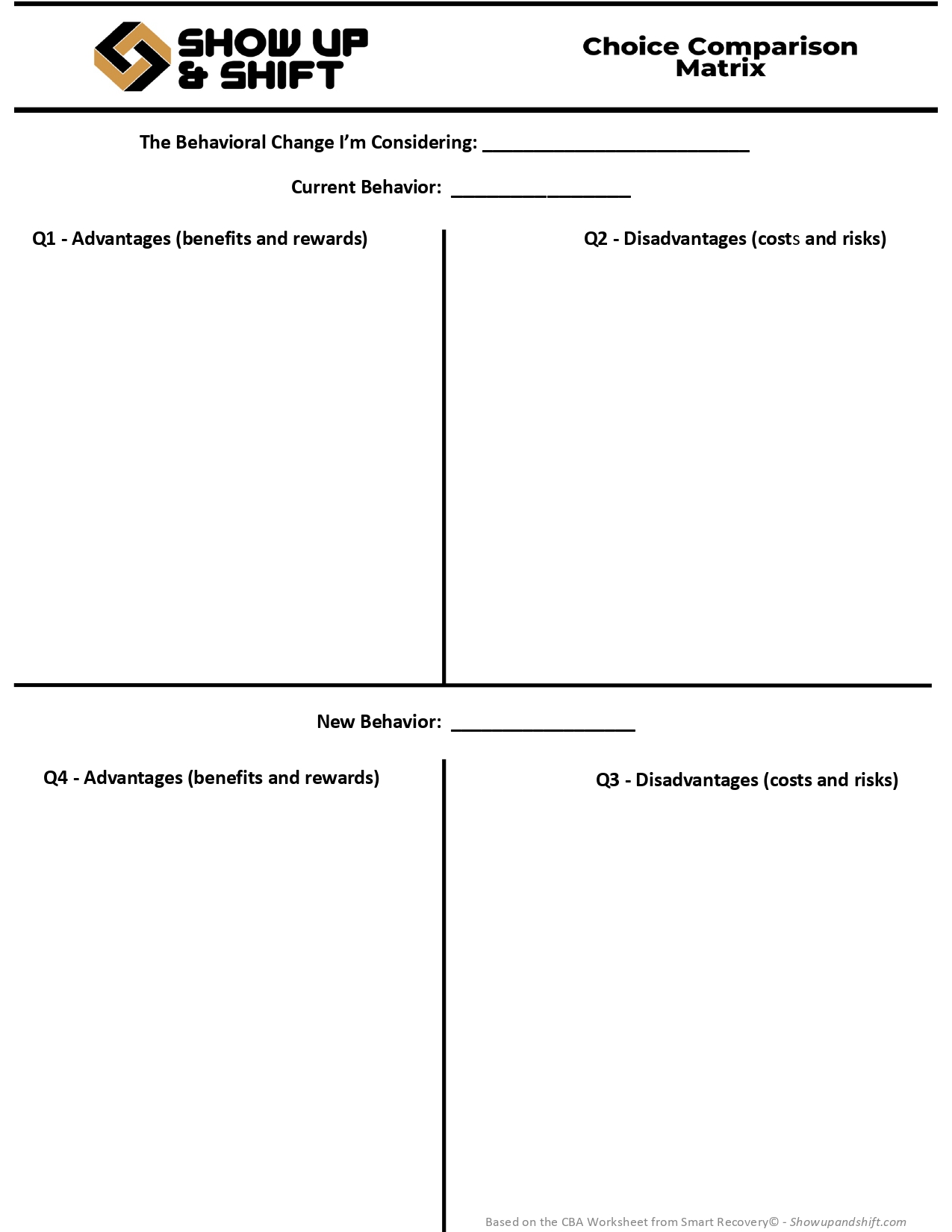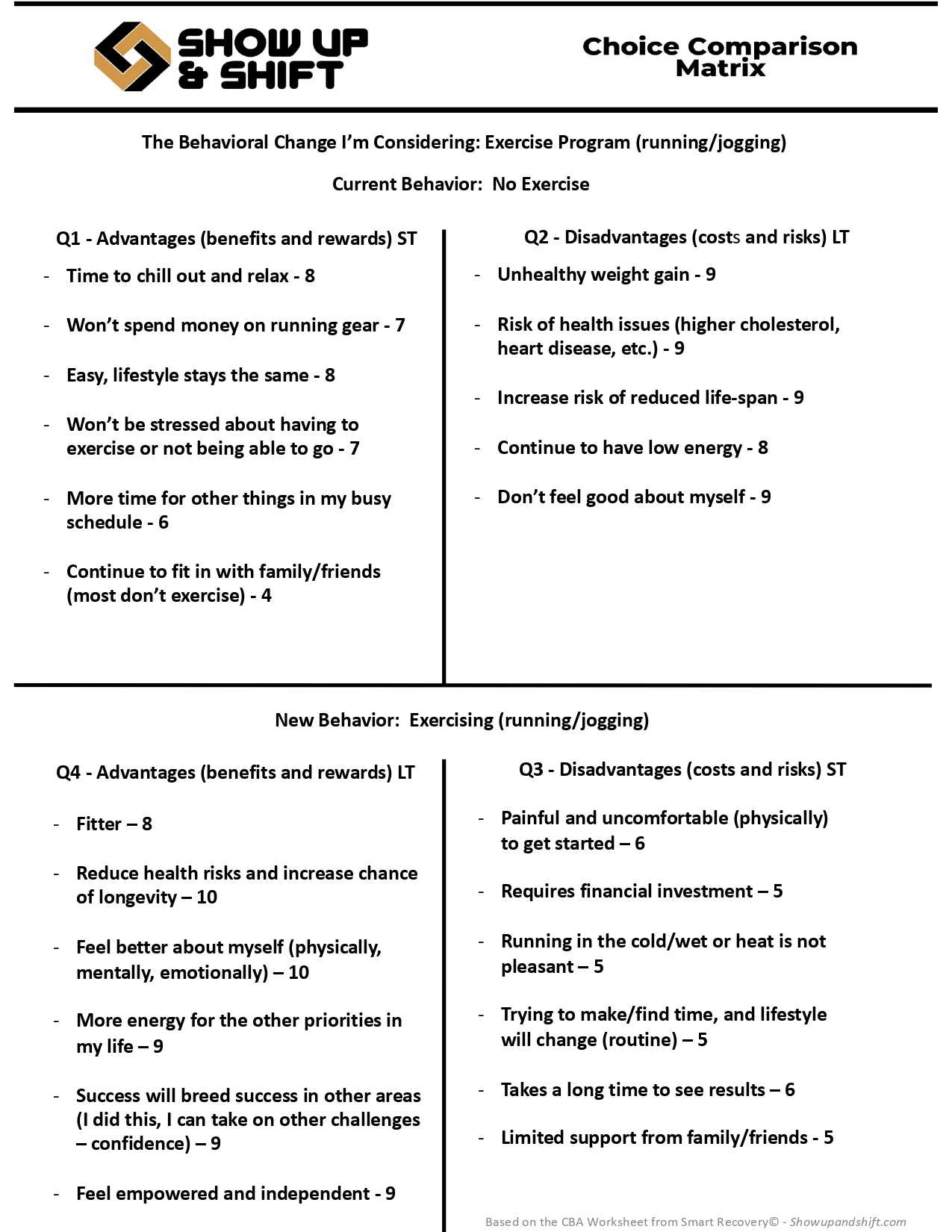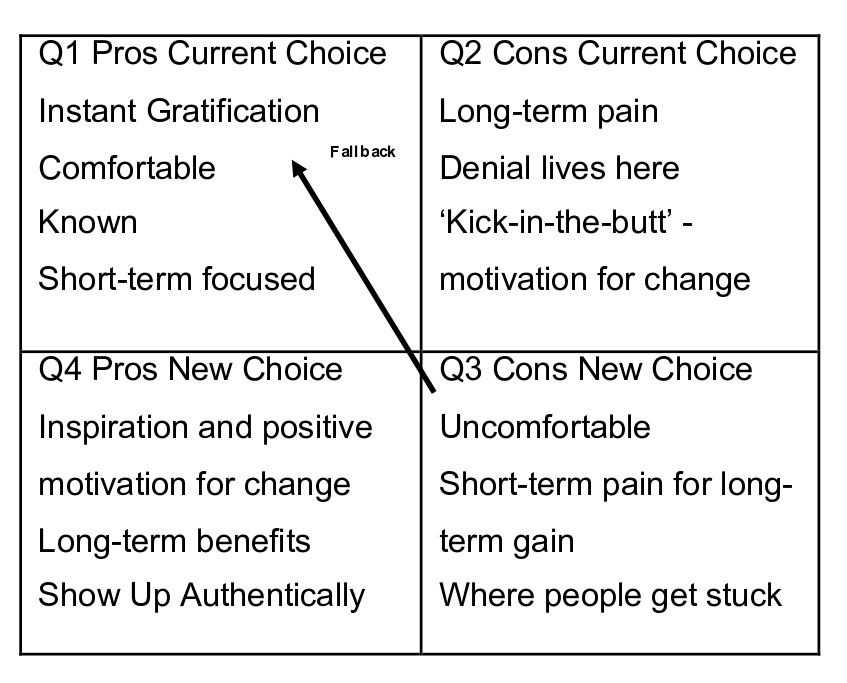 Image by Rudy and Peter Skitterians from Pixabay
Image by Rudy and Peter Skitterians from Pixabay
Approx. 10 minute read
Welcome to Part Six in the series of Practical Tools for Improving Your Mental and Emotional Well-Being.
It’s time to become Empowered by Choice.
Empowered by Choice
One perspective on the quality of life is to think about it in terms of your choices.
You make hundreds of choices each day: what to wear, eat, say, when to go to sleep, etc. They all contribute to your quality of life and affect your emotional and mental well-being.
And behavioral choices (many of which are habitual) are no different. These choices are usually made from the subconscious (default beliefs and patterns of behaving based on a situation or memory), or a combination of the subconscious and the barely conscious (a smidgen of attention given to a decision by your conscious mind).
To make empowered choices means making conscious choices, ones that align with your authenticity and desired emotional state(s).
A refresher from part one in this series, Your Thoughts are Powerful.

To change your default way of behaving, you need to change your thoughts and beliefs. But if it was easy there would not be the massive number of failed New Year’s resolutions. Studies have shown up to 80% of those resolutions fail, usually within the first few weeks of January.
This article provides a tool based on a well-known methodology that will help you make, and keep, better choices to support your mental and emotional well-being.
Welcome to the Choice Comparison Matrix (CCM).
The CCM provides a logical approach to reviewing the advantages and disadvantages to both sides of a behavioral change – keeping the current one or changing it. One empowering outcome of the CCM is the clarity and confidence it gives to your decision making. Every important aspect is part of the decision process. It’s personal, lessens overthinking, and ensures all important factors are considered.
The CCM tool has been a life-changer for me. I used it extensively to recover from alcohol dependency. It helped me immensely to choose and maintain recovery. And I have used the tool for other significant decisions: ending a career, starting a new relationship, choosing a simplistic lifestyle, becoming vegetarian, making my overall health a priority, and more.
The basic premise is to list the Advantages and Disadvantages of your current behavior, then the Advantages and Disadvantages of the behavior change.
Here is a sample template for the CCM tool.

How It Works
Think of a behavior you are considering changing (the Contemplation Phase from the Stages of Change model from Part 2: How You Learn).
Important:
- You are going to list all items that are important to you as part of the choice consideration. Being specific provides a clear picture of the advantages and disadvantages of each option. Use tangible examples. Include your feelings and emotions.
- Fill in the quadrants in the order listed. This methodology helps build motivation for the change of the behavior being considered.
- As with every concept and tool in these articles, the value you receive equates to your level of honesty with yourself.
Step 1: At the top of the matrix, list the Behavior you are considering changing (e.g. smoking).
Step 2: Fill in the top two quadrants of the matrix – reviewing the current choice (As Is/Status Quo).
- First, fill in the Advantages quadrant (Q1). List all the benefits of your current behavior. What does it do for you? Be specific. List as many benefits as you can about the current choice. There are good reasons you have chosen this particular behavior, even though you are considering an alternative.
- In the Disadvantages quadrant (Q2), list all the drawbacks and challenges about the current behavior. Include all potential and known difficulties. Be specific. List as many challenging aspects as you can. These are likely the reasons you are considering a change.
Step 3: Now repeat the process for the new behavior in the bottom quadrants (Q3 and Q4) of the matrix.
- In the Disadvantages quadrant (Q3) of the new choice, list all the concerns and challenges with adopting the new behavior. Include the potential, perceived, and known difficulties. Be specific. List as many challenging aspects as you can. These are usually the reasons that prevent you from following through with a change.
- In the Advantages quadrant (Q4), list everything you will appreciate about the new behavior choice. What will it do for you? Be specific. List all benefits that are possible outcomes of choosing the new behavior.
Step 4: Rate each item listed, one quadrant at a time, from 1-10 in importance to you, with 1 having the least importance (of impact or desire), and 10 having the greatest importance (of impact or desire).
Review the CCM so far.
- Do you notice any patterns?
- What areas in life seem to be important to you (external validation, empowerment, independence, freedom, family, friends, health, financial, career, avoiding conflict, what others think, what you “should do”, etc.)?
- Do these areas seem reasonable and healthy to you?
- Which items will help you thrive and achieve your long-term goals?
- Do the items belong to you or are they the result of someone else’s opinions?
- Do certain items even belong on the list?
You’ve listed all the Advantages and Disadvantages that are important to you as part of the decision-making process. It’s time to look at the CCM again, now with a short and long-term focus.
Review each item in all four quadrants and mark them as either having short-term (ST) or long-term (LT) implications for you.
Most items listed within a quadrant will either be ST or LT. Label the entire quadrant accordingly (ST or LT).
In most cases, Q1 and Q3 have short-termed outcomes, and Q2 and Q4 have long-term implications.
Here is a completed CCM example for someone considering an exercise program (running/jogging).

Each quadrant in the CCM provides other valuable information for your consideration.
Q1: Advantages of No Change
Typically, the advantages here align with instant gratification (short-term gain). Not always, but usually. Whether you smoke, drink, game, gamble, don’t exercise, etc., this choice is usually the easier and known choice (the “devil you know”).
Q2: Disadvantages of No Change
This quadrant is about denial – until you can’t hide your head in the sand anymore. It highlights the challenges of staying the same, which comes with long-term consequences. It is an uncomfortable place to be aware of, and once you are aware, it is difficult to “unknow what you know”. This quadrant is great for creating kick-in-the-butt motivation to choose change.
Q3: Disadvantages of Change
This quadrant is also about discomfort. But here, the challenges are associated with the new behavior (the devil you don’t know). It will take time and effort to change behavior and to create a new set of neural pathways. This is the quadrant where most people get derailed on their New Year’s resolutions. There is a limited feeling of immediate success (instant gratification). Many people hit roadblocks here and revert to the Advantages of the old behavior and lose the motivation for change. However, the discomfort here is short-term. It’s important to recognize the challenges, pitfalls, and tendency to revert to the known and comfortable of the current behavior. Knowing this information increases the likelihood of successful change. Forewarned is forearmed.
Q4: Advantages of Change
This is home to long-term satisfaction and the place of positive motivation and inspiration for when the going gets tough (the challenges of Q3). It’s important to focus on the end state of positive change – reaching the top of the mountain while acknowledging the success of every single step along the way.
A suggestion (a very strong one): focus on Q2 for negative motivation, and Q4 for positive motivation and inspiration. If your attention is on Q1 and Q3, you are more likely to revert to your current behavior choice.
Go into the CCM prepared, knowing the challenges and benefits to both the current choice and the new one. This is why honesty is important. Do not get blindsided by the realities and possibilities of either choice.

Here are some vital questions to ask yourself after completing a CCM.
- Which choice best supports my desired emotional state(s), desired way of being (my authentic self), and my top priorities?
- Which items listed are in or out of my control? How important am I making those that are out of my control?
- Are there items listed based on what others expect of me, or what I think I should do?
The more you use the CCM the easier it gets. You will find yourself doing a CCM in your head for everyday decisions: What will I have for a snack? Should I watch TV or read a book? Double latté or fresh juice? Is this friendship worth my energy? Which colleague should I discuss the challenges I’m having with the proposal? Should I share my thoughts and emotions about this situation with my partner?
You will make decisions based on the understanding that each choice has short and/or long-term benefits/consequences, and either supports your priorities and authenticity, mental and emotional well-being, or not.
With each choice, you decide how you will Show Up in the world. With each decision you make to support your mental and emotional well-being, you are choosing to be Empowered by Choice.
Here is the link to Part 7 in this series, Emotionally Aware.
For a free copy of a comprehensive PDF workbook on these tools and concepts, send me an email at [email protected]. I appreciate receiving your comments and feedback.
~~~~~
For more techniques and tools for your mental and emotional well-being, check out my unique and engaging self-improvement novel, The Shift Squad.
 I write to inspire others to greater self-empowerment, authenticity, and improved emotional and mental well-being.
I write to inspire others to greater self-empowerment, authenticity, and improved emotional and mental well-being.
I am the author of the unique personal development novel The Shift Squad.
If you like what you read please subscribe for updates, share my articles with others, and add your comments below.
You can connect with me via email at [email protected] , on Facebook, Twitter, and LinkedIn.
Be Empowered. Make Authentic Choices And Enhance Your Quality Of Life.
